Nespresso Case: Innovation, Renovation, and Competitive Advantage
VerifiedAdded on 2023/06/13
|14
|3956
|88
Case Study
AI Summary
This case study delves into Nespresso's successful strategies for achieving a competitive advantage in the global coffee market through innovation and renovation. It highlights how Nespresso, under Nestle's parentage, revolutionized the coffee industry by focusing on a unique market position and aligning its strategies to achieve its goals. The company innovated by creating a coffee capsule system usable only with its exclusively designed machines, masking complexity with simplicity and securing patents while licensing production. Key strategies included targeting a high-income customer segment, focusing on product quality through Nestle's R&D, and establishing direct customer relationships via the Nespresso Club. The case also discusses the importance of market penetration and product development, suggesting strategies for Nestle Coffee Specialties to increase their future business potential and meet ambitious growth targets by diversifying coffee variants and packaging sizes to reach broader customer segments. It emphasizes the need for continuous innovation, proper leadership, and risk-taking to sustain growth and adapt to evolving market trends.
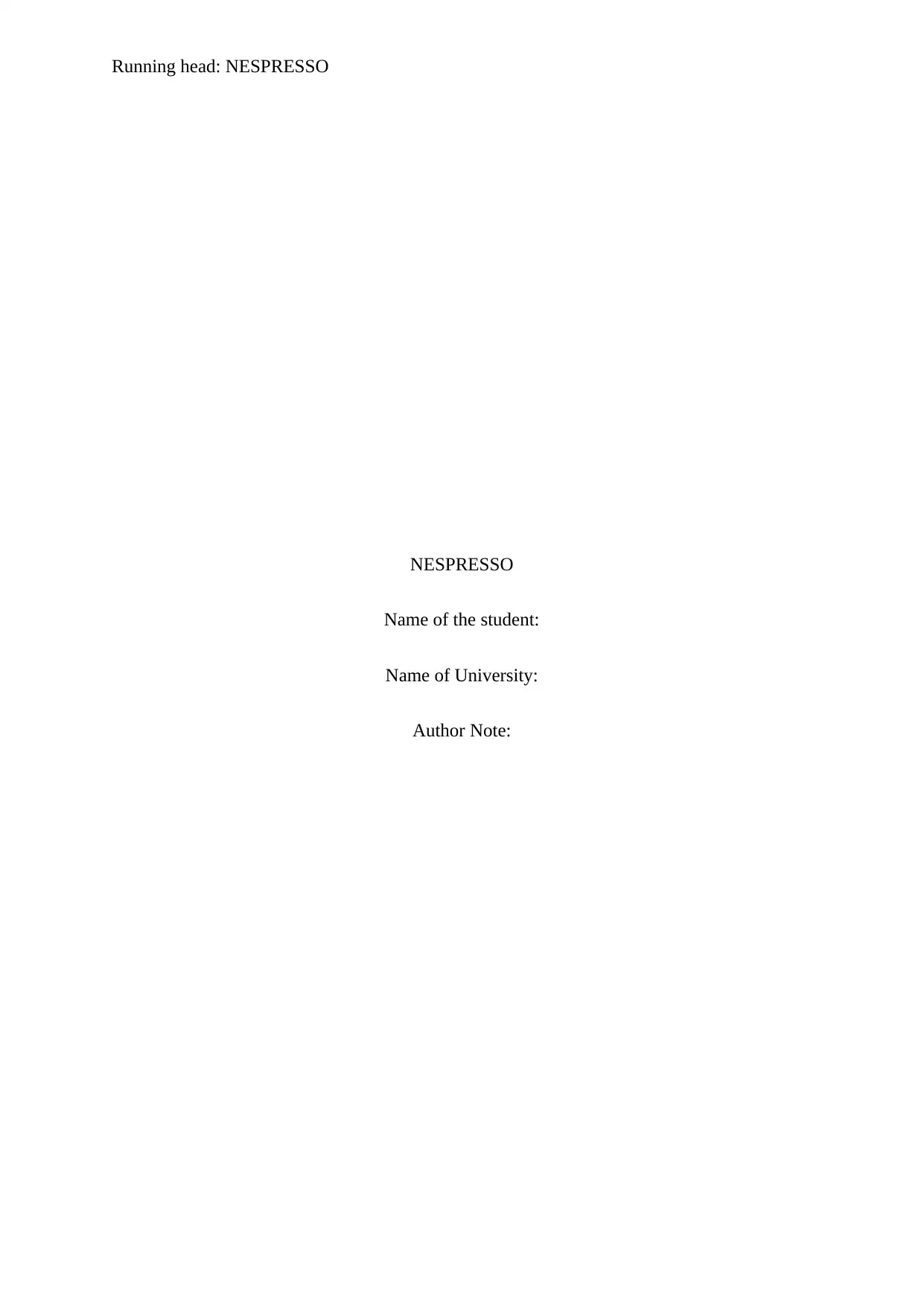
Running head: NESPRESSO
NESPRESSO
Name of the student:
Name of University:
Author Note:
NESPRESSO
Name of the student:
Name of University:
Author Note:
Paraphrase This Document
Need a fresh take? Get an instant paraphrase of this document with our AI Paraphraser

1NESPRESSO
Answer to question 1.
Nespresso is one of the most successful coffee brand which aimed to attain
competitive advantage in the markets all over the world. For this reason, it followed the path
of renovation and innovation and changed the game in its industry. This company conquered
the battle by applying numerous strategiesbut aimed them to bring a perfect alignment to
reach unique market position. However, it took a long time to achieve the goals laid by the
brand and it came to failure more than once. Despite the fact that the company is doing well
in the current situation but these strategies will not be able to save the company from
thechallenges in future. Hence the company has to follow differedstrategies to support the
idea of innovation.
The idea of innovation is a continuous process. In case of Nespresso, it is a non-linear
process which helped the company to gain competitive advantage (Sung and Choi 2014).
Through innovation strategy the brandshave become one of the fastest growing businesses
from uncertain beginning. Under the parentage of one of the leading global food companies,
Nestle, Nespresso has proved to be the successful fruit of innovation strategy. Before
Nespresso, there were varietyof new and existing products which Nestle hadinnovated or
renovated then tested successfully before exposing them into the western market. Nespresso
is one of the most importantinnovation of the company as it not onlyincreased the revenue
but alsoprovided an extra leverage to the company’s other productions such as machines and
other coffee products like Nescafe.
The success of theglobal brand alwaysdepends on the renovation and innovation
process.Innovation helps the bends to take something into the next category andrenovation is
the method of keeping product in same category but introduce with more improvements
(Brem, Maier and Wimschneider2016). For Nespresso, the improvement or innovation was
Answer to question 1.
Nespresso is one of the most successful coffee brand which aimed to attain
competitive advantage in the markets all over the world. For this reason, it followed the path
of renovation and innovation and changed the game in its industry. This company conquered
the battle by applying numerous strategiesbut aimed them to bring a perfect alignment to
reach unique market position. However, it took a long time to achieve the goals laid by the
brand and it came to failure more than once. Despite the fact that the company is doing well
in the current situation but these strategies will not be able to save the company from
thechallenges in future. Hence the company has to follow differedstrategies to support the
idea of innovation.
The idea of innovation is a continuous process. In case of Nespresso, it is a non-linear
process which helped the company to gain competitive advantage (Sung and Choi 2014).
Through innovation strategy the brandshave become one of the fastest growing businesses
from uncertain beginning. Under the parentage of one of the leading global food companies,
Nestle, Nespresso has proved to be the successful fruit of innovation strategy. Before
Nespresso, there were varietyof new and existing products which Nestle hadinnovated or
renovated then tested successfully before exposing them into the western market. Nespresso
is one of the most importantinnovation of the company as it not onlyincreased the revenue
but alsoprovided an extra leverage to the company’s other productions such as machines and
other coffee products like Nescafe.
The success of theglobal brand alwaysdepends on the renovation and innovation
process.Innovation helps the bends to take something into the next category andrenovation is
the method of keeping product in same category but introduce with more improvements
(Brem, Maier and Wimschneider2016). For Nespresso, the improvement or innovation was
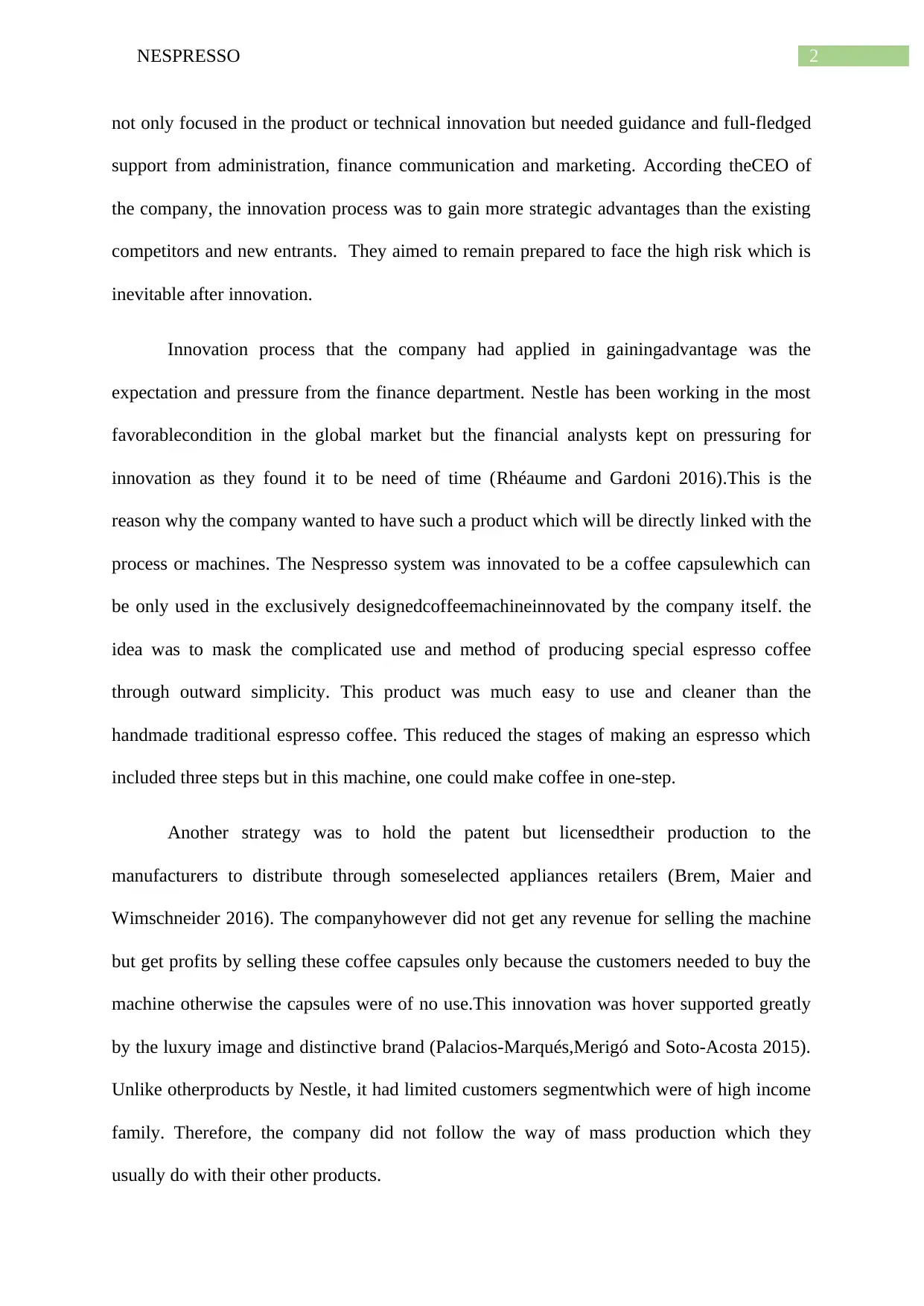
2NESPRESSO
not only focused in the product or technical innovation but needed guidance and full-fledged
support from administration, finance communication and marketing. According theCEO of
the company, the innovation process was to gain more strategic advantages than the existing
competitors and new entrants. They aimed to remain prepared to face the high risk which is
inevitable after innovation.
Innovation process that the company had applied in gainingadvantage was the
expectation and pressure from the finance department. Nestle has been working in the most
favorablecondition in the global market but the financial analysts kept on pressuring for
innovation as they found it to be need of time (Rhéaume and Gardoni 2016).This is the
reason why the company wanted to have such a product which will be directly linked with the
process or machines. The Nespresso system was innovated to be a coffee capsulewhich can
be only used in the exclusively designedcoffeemachineinnovated by the company itself. the
idea was to mask the complicated use and method of producing special espresso coffee
through outward simplicity. This product was much easy to use and cleaner than the
handmade traditional espresso coffee. This reduced the stages of making an espresso which
included three steps but in this machine, one could make coffee in one-step.
Another strategy was to hold the patent but licensedtheir production to the
manufacturers to distribute through someselected appliances retailers (Brem, Maier and
Wimschneider 2016). The companyhowever did not get any revenue for selling the machine
but get profits by selling these coffee capsules only because the customers needed to buy the
machine otherwise the capsules were of no use.This innovation was hover supported greatly
by the luxury image and distinctive brand (Palacios-Marqués,Merigó and Soto-Acosta 2015).
Unlike otherproducts by Nestle, it had limited customers segmentwhich were of high income
family. Therefore, the company did not follow the way of mass production which they
usually do with their other products.
not only focused in the product or technical innovation but needed guidance and full-fledged
support from administration, finance communication and marketing. According theCEO of
the company, the innovation process was to gain more strategic advantages than the existing
competitors and new entrants. They aimed to remain prepared to face the high risk which is
inevitable after innovation.
Innovation process that the company had applied in gainingadvantage was the
expectation and pressure from the finance department. Nestle has been working in the most
favorablecondition in the global market but the financial analysts kept on pressuring for
innovation as they found it to be need of time (Rhéaume and Gardoni 2016).This is the
reason why the company wanted to have such a product which will be directly linked with the
process or machines. The Nespresso system was innovated to be a coffee capsulewhich can
be only used in the exclusively designedcoffeemachineinnovated by the company itself. the
idea was to mask the complicated use and method of producing special espresso coffee
through outward simplicity. This product was much easy to use and cleaner than the
handmade traditional espresso coffee. This reduced the stages of making an espresso which
included three steps but in this machine, one could make coffee in one-step.
Another strategy was to hold the patent but licensedtheir production to the
manufacturers to distribute through someselected appliances retailers (Brem, Maier and
Wimschneider 2016). The companyhowever did not get any revenue for selling the machine
but get profits by selling these coffee capsules only because the customers needed to buy the
machine otherwise the capsules were of no use.This innovation was hover supported greatly
by the luxury image and distinctive brand (Palacios-Marqués,Merigó and Soto-Acosta 2015).
Unlike otherproducts by Nestle, it had limited customers segmentwhich were of high income
family. Therefore, the company did not follow the way of mass production which they
usually do with their other products.
⊘ This is a preview!⊘
Do you want full access?
Subscribe today to unlock all pages.

Trusted by 1+ million students worldwide
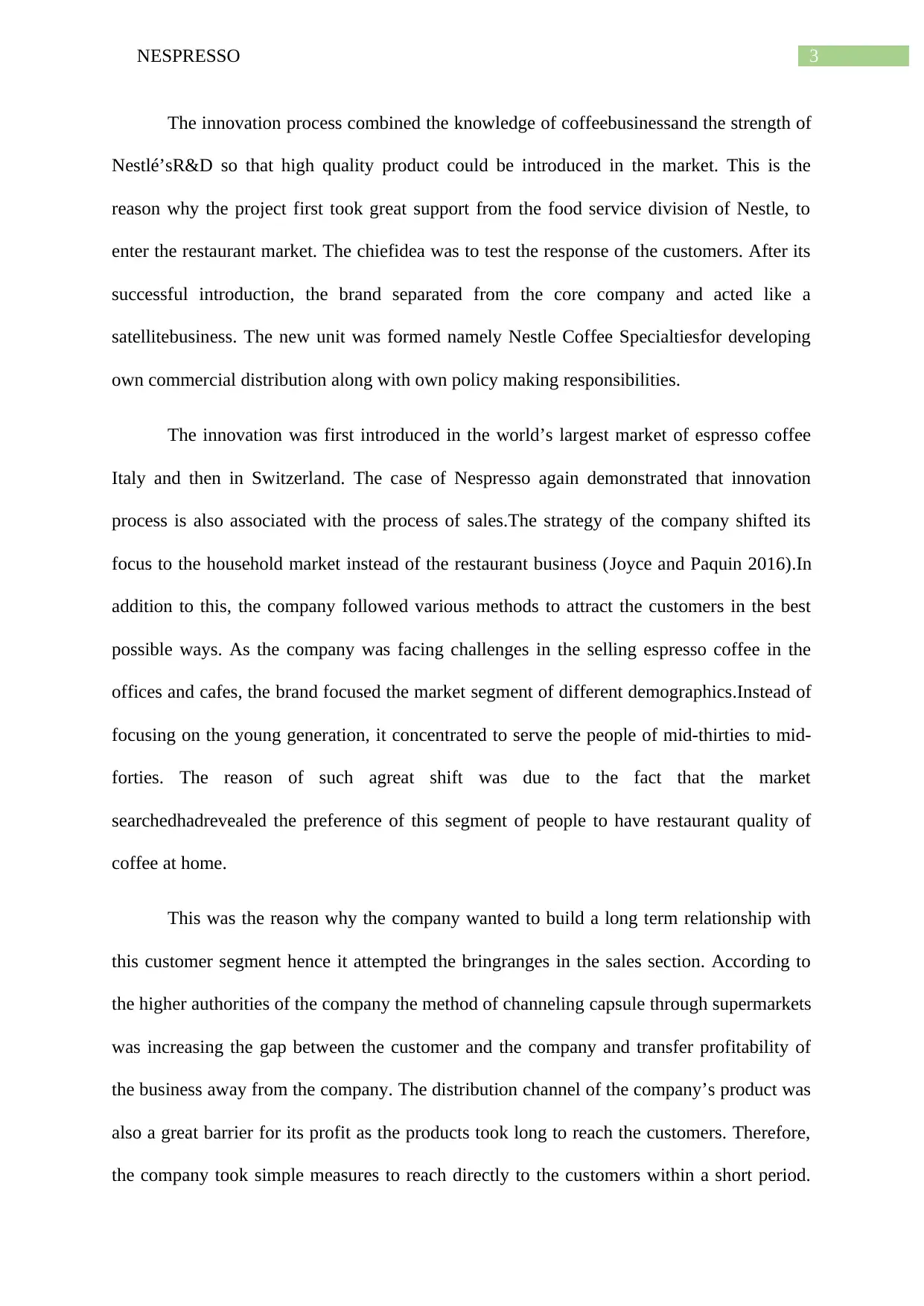
3NESPRESSO
The innovation process combined the knowledge of coffeebusinessand the strength of
Nestlé’sR&D so that high quality product could be introduced in the market. This is the
reason why the project first took great support from the food service division of Nestle, to
enter the restaurant market. The chiefidea was to test the response of the customers. After its
successful introduction, the brand separated from the core company and acted like a
satellitebusiness. The new unit was formed namely Nestle Coffee Specialtiesfor developing
own commercial distribution along with own policy making responsibilities.
The innovation was first introduced in the world’s largest market of espresso coffee
Italy and then in Switzerland. The case of Nespresso again demonstrated that innovation
process is also associated with the process of sales.The strategy of the company shifted its
focus to the household market instead of the restaurant business (Joyce and Paquin 2016).In
addition to this, the company followed various methods to attract the customers in the best
possible ways. As the company was facing challenges in the selling espresso coffee in the
offices and cafes, the brand focused the market segment of different demographics.Instead of
focusing on the young generation, it concentrated to serve the people of mid-thirties to mid-
forties. The reason of such agreat shift was due to the fact that the market
searchedhadrevealed the preference of this segment of people to have restaurant quality of
coffee at home.
This was the reason why the company wanted to build a long term relationship with
this customer segment hence it attempted the bringranges in the sales section. According to
the higher authorities of the company the method of channeling capsule through supermarkets
was increasing the gap between the customer and the company and transfer profitability of
the business away from the company. The distribution channel of the company’s product was
also a great barrier for its profit as the products took long to reach the customers. Therefore,
the company took simple measures to reach directly to the customers within a short period.
The innovation process combined the knowledge of coffeebusinessand the strength of
Nestlé’sR&D so that high quality product could be introduced in the market. This is the
reason why the project first took great support from the food service division of Nestle, to
enter the restaurant market. The chiefidea was to test the response of the customers. After its
successful introduction, the brand separated from the core company and acted like a
satellitebusiness. The new unit was formed namely Nestle Coffee Specialtiesfor developing
own commercial distribution along with own policy making responsibilities.
The innovation was first introduced in the world’s largest market of espresso coffee
Italy and then in Switzerland. The case of Nespresso again demonstrated that innovation
process is also associated with the process of sales.The strategy of the company shifted its
focus to the household market instead of the restaurant business (Joyce and Paquin 2016).In
addition to this, the company followed various methods to attract the customers in the best
possible ways. As the company was facing challenges in the selling espresso coffee in the
offices and cafes, the brand focused the market segment of different demographics.Instead of
focusing on the young generation, it concentrated to serve the people of mid-thirties to mid-
forties. The reason of such agreat shift was due to the fact that the market
searchedhadrevealed the preference of this segment of people to have restaurant quality of
coffee at home.
This was the reason why the company wanted to build a long term relationship with
this customer segment hence it attempted the bringranges in the sales section. According to
the higher authorities of the company the method of channeling capsule through supermarkets
was increasing the gap between the customer and the company and transfer profitability of
the business away from the company. The distribution channel of the company’s product was
also a great barrier for its profit as the products took long to reach the customers. Therefore,
the company took simple measures to reach directly to the customers within a short period.
Paraphrase This Document
Need a fresh take? Get an instant paraphrase of this document with our AI Paraphraser
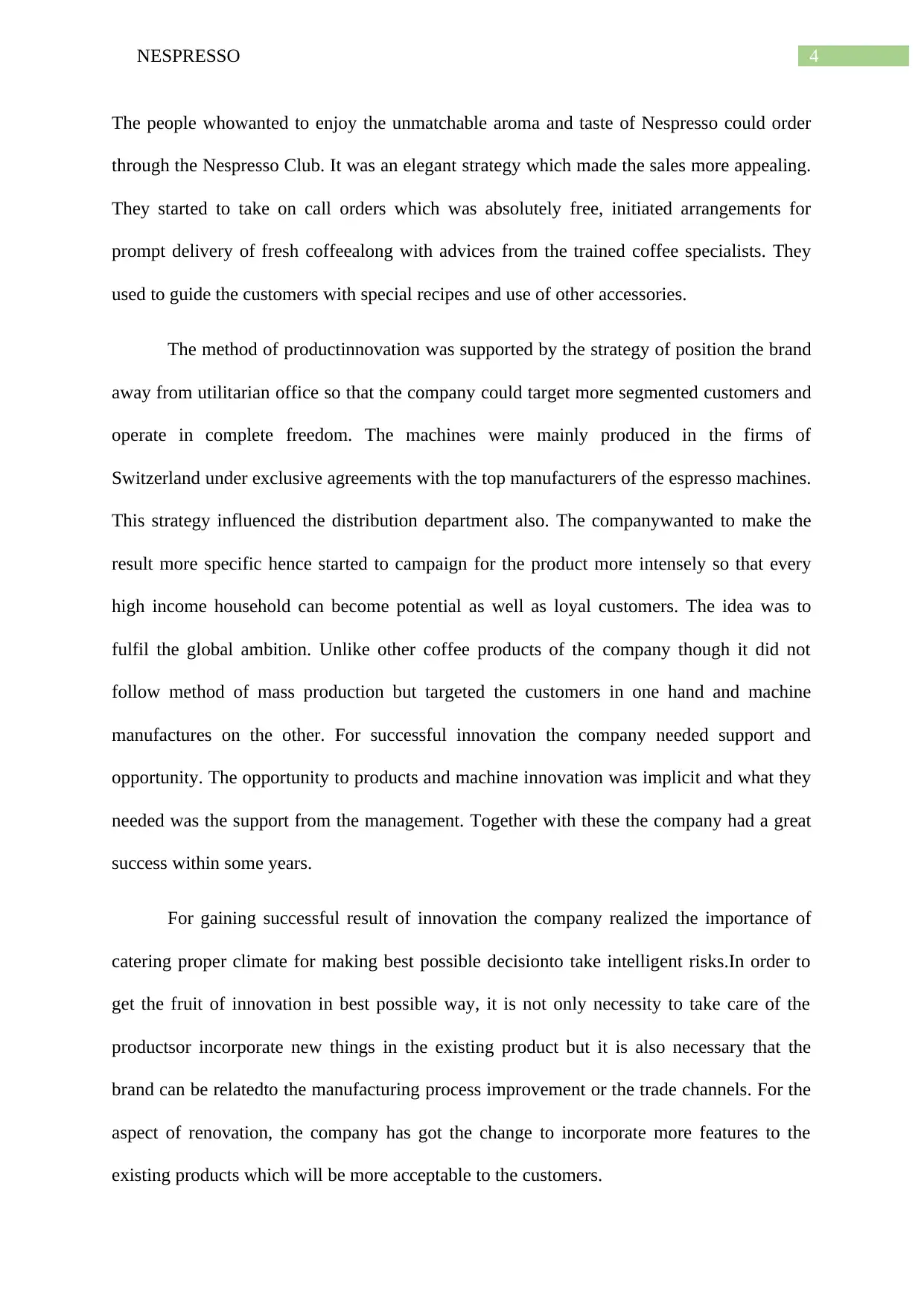
4NESPRESSO
The people whowanted to enjoy the unmatchable aroma and taste of Nespresso could order
through the Nespresso Club. It was an elegant strategy which made the sales more appealing.
They started to take on call orders which was absolutely free, initiated arrangements for
prompt delivery of fresh coffeealong with advices from the trained coffee specialists. They
used to guide the customers with special recipes and use of other accessories.
The method of productinnovation was supported by the strategy of position the brand
away from utilitarian office so that the company could target more segmented customers and
operate in complete freedom. The machines were mainly produced in the firms of
Switzerland under exclusive agreements with the top manufacturers of the espresso machines.
This strategy influenced the distribution department also. The companywanted to make the
result more specific hence started to campaign for the product more intensely so that every
high income household can become potential as well as loyal customers. The idea was to
fulfil the global ambition. Unlike other coffee products of the company though it did not
follow method of mass production but targeted the customers in one hand and machine
manufactures on the other. For successful innovation the company needed support and
opportunity. The opportunity to products and machine innovation was implicit and what they
needed was the support from the management. Together with these the company had a great
success within some years.
For gaining successful result of innovation the company realized the importance of
catering proper climate for making best possible decisionto take intelligent risks.In order to
get the fruit of innovation in best possible way, it is not only necessity to take care of the
productsor incorporate new things in the existing product but it is also necessary that the
brand can be relatedto the manufacturing process improvement or the trade channels. For the
aspect of renovation, the company has got the change to incorporate more features to the
existing products which will be more acceptable to the customers.
The people whowanted to enjoy the unmatchable aroma and taste of Nespresso could order
through the Nespresso Club. It was an elegant strategy which made the sales more appealing.
They started to take on call orders which was absolutely free, initiated arrangements for
prompt delivery of fresh coffeealong with advices from the trained coffee specialists. They
used to guide the customers with special recipes and use of other accessories.
The method of productinnovation was supported by the strategy of position the brand
away from utilitarian office so that the company could target more segmented customers and
operate in complete freedom. The machines were mainly produced in the firms of
Switzerland under exclusive agreements with the top manufacturers of the espresso machines.
This strategy influenced the distribution department also. The companywanted to make the
result more specific hence started to campaign for the product more intensely so that every
high income household can become potential as well as loyal customers. The idea was to
fulfil the global ambition. Unlike other coffee products of the company though it did not
follow method of mass production but targeted the customers in one hand and machine
manufactures on the other. For successful innovation the company needed support and
opportunity. The opportunity to products and machine innovation was implicit and what they
needed was the support from the management. Together with these the company had a great
success within some years.
For gaining successful result of innovation the company realized the importance of
catering proper climate for making best possible decisionto take intelligent risks.In order to
get the fruit of innovation in best possible way, it is not only necessity to take care of the
productsor incorporate new things in the existing product but it is also necessary that the
brand can be relatedto the manufacturing process improvement or the trade channels. For the
aspect of renovation, the company has got the change to incorporate more features to the
existing products which will be more acceptable to the customers.

5NESPRESSO
For innovation and renovation, the company needs to have inventor who will be
capable to feel the urgency of innovate a new product or renovate an existing product for the
company. The case of Nespresso, details that this innovation method can cause complex
andhigh risks thereforeproper leadership and an institution of potential individuals should be
present. They will make the innovation arenovation process quite constitutiveotherwise the
impact of innovation will not be fruitful for the company. The innovative idea that the
innovator aims toincorporate in the company need to be supported by the management so that
they can provide security as well as longevity to the innovation rather than keeping
concentration in running the core business more successfully.
Answer to question 2.
In the case study, it is discussed that Nestle Coffee Specialties is having ambitious growth
target, which was not being able to get fulfilled by their existing strategies. This is mainly due
to the reason all the strategies are being initiated and implemented without the effective
determination of the market trend and requirements. Thus, though the concept of the Nestle
Coffee Specialties is innovative and effective in nature, but it failed to succeed in the market.
The following sections will discuss about some of the activities or strategies that should be
initiated by the Nestle Coffee Specialties in order to increase their future business potentiality
and meet the determined target.
For innovation and renovation, the company needs to have inventor who will be
capable to feel the urgency of innovate a new product or renovate an existing product for the
company. The case of Nespresso, details that this innovation method can cause complex
andhigh risks thereforeproper leadership and an institution of potential individuals should be
present. They will make the innovation arenovation process quite constitutiveotherwise the
impact of innovation will not be fruitful for the company. The innovative idea that the
innovator aims toincorporate in the company need to be supported by the management so that
they can provide security as well as longevity to the innovation rather than keeping
concentration in running the core business more successfully.
Answer to question 2.
In the case study, it is discussed that Nestle Coffee Specialties is having ambitious growth
target, which was not being able to get fulfilled by their existing strategies. This is mainly due
to the reason all the strategies are being initiated and implemented without the effective
determination of the market trend and requirements. Thus, though the concept of the Nestle
Coffee Specialties is innovative and effective in nature, but it failed to succeed in the market.
The following sections will discuss about some of the activities or strategies that should be
initiated by the Nestle Coffee Specialties in order to increase their future business potentiality
and meet the determined target.
⊘ This is a preview!⊘
Do you want full access?
Subscribe today to unlock all pages.

Trusted by 1+ million students worldwide
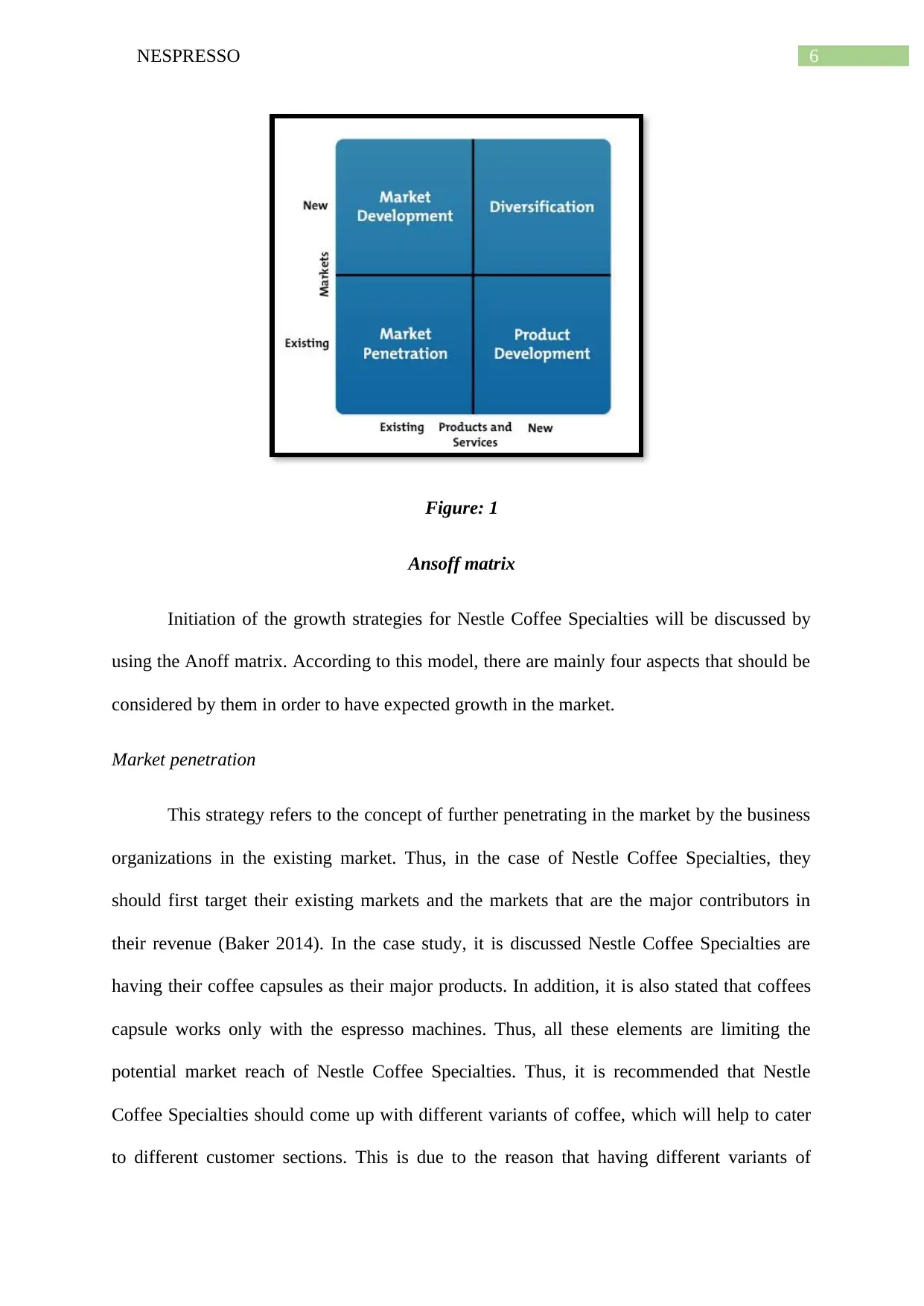
6NESPRESSO
Figure: 1
Ansoff matrix
Initiation of the growth strategies for Nestle Coffee Specialties will be discussed by
using the Anoff matrix. According to this model, there are mainly four aspects that should be
considered by them in order to have expected growth in the market.
Market penetration
This strategy refers to the concept of further penetrating in the market by the business
organizations in the existing market. Thus, in the case of Nestle Coffee Specialties, they
should first target their existing markets and the markets that are the major contributors in
their revenue (Baker 2014). In the case study, it is discussed Nestle Coffee Specialties are
having their coffee capsules as their major products. In addition, it is also stated that coffees
capsule works only with the espresso machines. Thus, all these elements are limiting the
potential market reach of Nestle Coffee Specialties. Thus, it is recommended that Nestle
Coffee Specialties should come up with different variants of coffee, which will help to cater
to different customer sections. This is due to the reason that having different variants of
Figure: 1
Ansoff matrix
Initiation of the growth strategies for Nestle Coffee Specialties will be discussed by
using the Anoff matrix. According to this model, there are mainly four aspects that should be
considered by them in order to have expected growth in the market.
Market penetration
This strategy refers to the concept of further penetrating in the market by the business
organizations in the existing market. Thus, in the case of Nestle Coffee Specialties, they
should first target their existing markets and the markets that are the major contributors in
their revenue (Baker 2014). In the case study, it is discussed Nestle Coffee Specialties are
having their coffee capsules as their major products. In addition, it is also stated that coffees
capsule works only with the espresso machines. Thus, all these elements are limiting the
potential market reach of Nestle Coffee Specialties. Thus, it is recommended that Nestle
Coffee Specialties should come up with different variants of coffee, which will help to cater
to different customer sections. This is due to the reason that having different variants of
Paraphrase This Document
Need a fresh take? Get an instant paraphrase of this document with our AI Paraphraser

7NESPRESSO
coffee will help to meet the diverse requirement of the customers (Basu 2014). For instance,
some customers will have convenience with the coffee powder while some will be
comfortable with other forms of coffee. Introducing different variants of coffee by Nestle
Coffee Specialties will help to maximize the market reach.
Another activity that should be initiated by Nestle Coffee Specialties in further
penetrating their existing market is introducing different sizes of the coffee products in the
market. This is important due to the reason that, the more will be the size variants of the
coffee products, the more will be the target segments for Nestle Coffee Specialties. This is
due to the fact that availability of the coffee products in different size and packaging will
ensure that the products will be available in different price levels (Besbes and Saure 2016).
For instance, coffee products of them available in smaller packets will cost less in the market
and it will be able to target the mass market. More customers can get attracted with having
product in lower price points.
Thus, it can be concluded that having more product variants and price variants will
help Nestle Coffee Specialties to gain more stronghold in their existing market along with
having more customer base. The more will be the market reach in the existing market, the
more will be the probability to increase the sales revenue and meet the growth target.
Product development
The next element of Ansoff matrix is product development. This concept refers to the
developing of the existing products in the existing market. In the case of Nestle Coffee
Specialties, it is recommended that they should come up with more new products in the
market in order to target the different and diverse need of their existing customers (Crawley,
Cameron and Selva 2015). In the case study, it is stated that Nestle Coffee Specialties is
already having coffee capsules as their major products along with the coffee clubs and coffee
coffee will help to meet the diverse requirement of the customers (Basu 2014). For instance,
some customers will have convenience with the coffee powder while some will be
comfortable with other forms of coffee. Introducing different variants of coffee by Nestle
Coffee Specialties will help to maximize the market reach.
Another activity that should be initiated by Nestle Coffee Specialties in further
penetrating their existing market is introducing different sizes of the coffee products in the
market. This is important due to the reason that, the more will be the size variants of the
coffee products, the more will be the target segments for Nestle Coffee Specialties. This is
due to the fact that availability of the coffee products in different size and packaging will
ensure that the products will be available in different price levels (Besbes and Saure 2016).
For instance, coffee products of them available in smaller packets will cost less in the market
and it will be able to target the mass market. More customers can get attracted with having
product in lower price points.
Thus, it can be concluded that having more product variants and price variants will
help Nestle Coffee Specialties to gain more stronghold in their existing market along with
having more customer base. The more will be the market reach in the existing market, the
more will be the probability to increase the sales revenue and meet the growth target.
Product development
The next element of Ansoff matrix is product development. This concept refers to the
developing of the existing products in the existing market. In the case of Nestle Coffee
Specialties, it is recommended that they should come up with more new products in the
market in order to target the different and diverse need of their existing customers (Crawley,
Cameron and Selva 2015). In the case study, it is stated that Nestle Coffee Specialties is
already having coffee capsules as their major products along with the coffee clubs and coffee
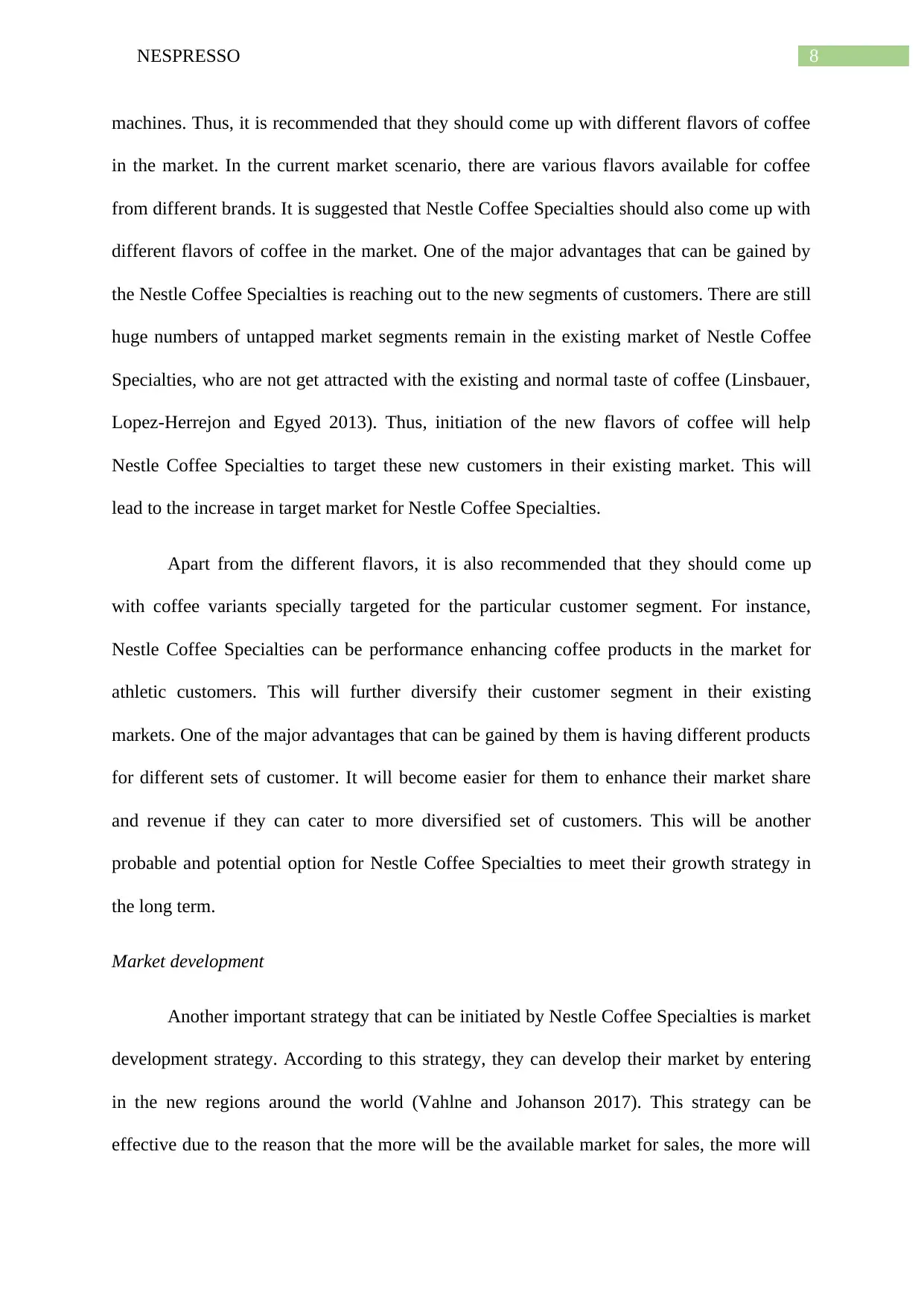
8NESPRESSO
machines. Thus, it is recommended that they should come up with different flavors of coffee
in the market. In the current market scenario, there are various flavors available for coffee
from different brands. It is suggested that Nestle Coffee Specialties should also come up with
different flavors of coffee in the market. One of the major advantages that can be gained by
the Nestle Coffee Specialties is reaching out to the new segments of customers. There are still
huge numbers of untapped market segments remain in the existing market of Nestle Coffee
Specialties, who are not get attracted with the existing and normal taste of coffee (Linsbauer,
Lopez-Herrejon and Egyed 2013). Thus, initiation of the new flavors of coffee will help
Nestle Coffee Specialties to target these new customers in their existing market. This will
lead to the increase in target market for Nestle Coffee Specialties.
Apart from the different flavors, it is also recommended that they should come up
with coffee variants specially targeted for the particular customer segment. For instance,
Nestle Coffee Specialties can be performance enhancing coffee products in the market for
athletic customers. This will further diversify their customer segment in their existing
markets. One of the major advantages that can be gained by them is having different products
for different sets of customer. It will become easier for them to enhance their market share
and revenue if they can cater to more diversified set of customers. This will be another
probable and potential option for Nestle Coffee Specialties to meet their growth strategy in
the long term.
Market development
Another important strategy that can be initiated by Nestle Coffee Specialties is market
development strategy. According to this strategy, they can develop their market by entering
in the new regions around the world (Vahlne and Johanson 2017). This strategy can be
effective due to the reason that the more will be the available market for sales, the more will
machines. Thus, it is recommended that they should come up with different flavors of coffee
in the market. In the current market scenario, there are various flavors available for coffee
from different brands. It is suggested that Nestle Coffee Specialties should also come up with
different flavors of coffee in the market. One of the major advantages that can be gained by
the Nestle Coffee Specialties is reaching out to the new segments of customers. There are still
huge numbers of untapped market segments remain in the existing market of Nestle Coffee
Specialties, who are not get attracted with the existing and normal taste of coffee (Linsbauer,
Lopez-Herrejon and Egyed 2013). Thus, initiation of the new flavors of coffee will help
Nestle Coffee Specialties to target these new customers in their existing market. This will
lead to the increase in target market for Nestle Coffee Specialties.
Apart from the different flavors, it is also recommended that they should come up
with coffee variants specially targeted for the particular customer segment. For instance,
Nestle Coffee Specialties can be performance enhancing coffee products in the market for
athletic customers. This will further diversify their customer segment in their existing
markets. One of the major advantages that can be gained by them is having different products
for different sets of customer. It will become easier for them to enhance their market share
and revenue if they can cater to more diversified set of customers. This will be another
probable and potential option for Nestle Coffee Specialties to meet their growth strategy in
the long term.
Market development
Another important strategy that can be initiated by Nestle Coffee Specialties is market
development strategy. According to this strategy, they can develop their market by entering
in the new regions around the world (Vahlne and Johanson 2017). This strategy can be
effective due to the reason that the more will be the available market for sales, the more will
⊘ This is a preview!⊘
Do you want full access?
Subscribe today to unlock all pages.

Trusted by 1+ million students worldwide
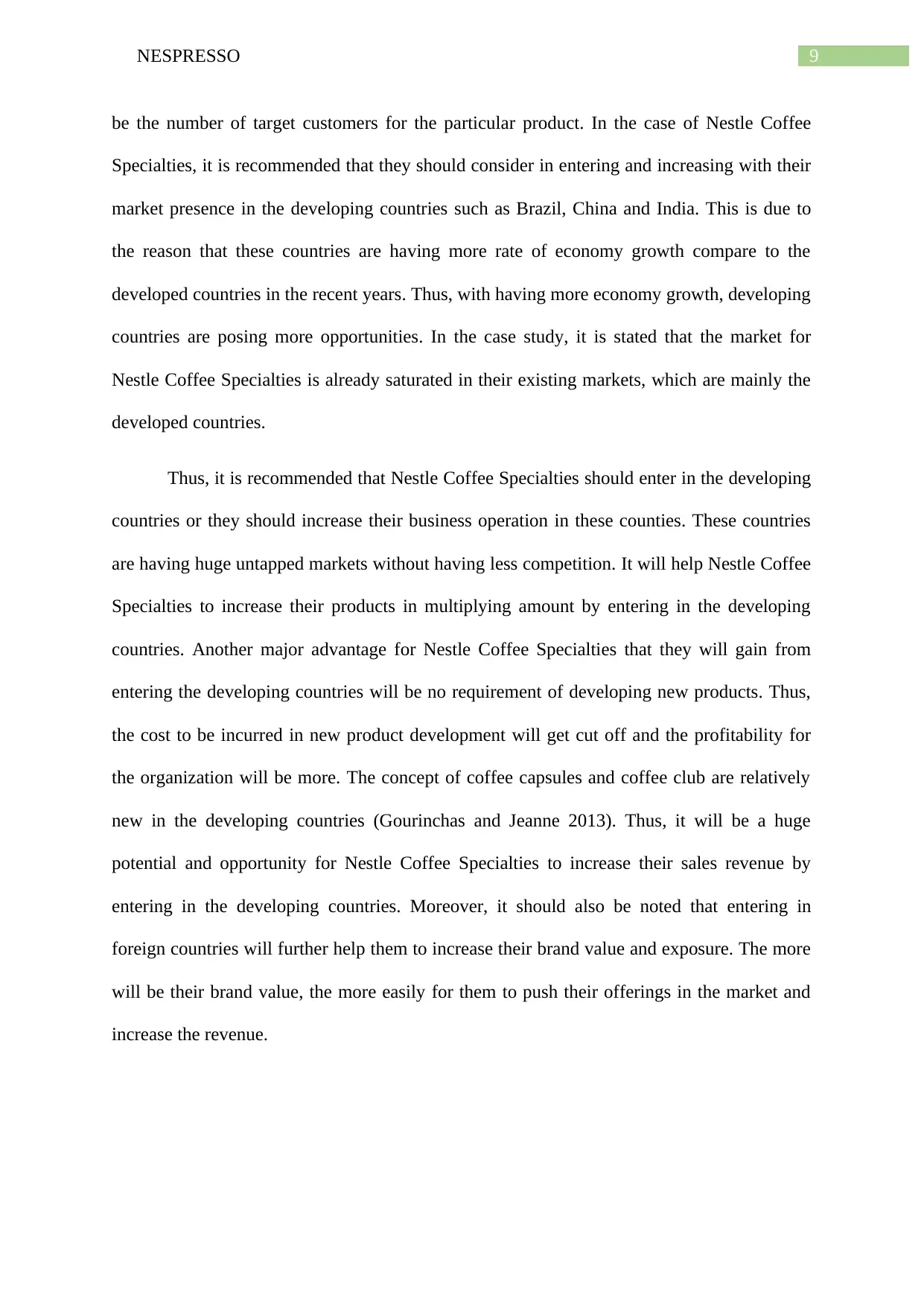
9NESPRESSO
be the number of target customers for the particular product. In the case of Nestle Coffee
Specialties, it is recommended that they should consider in entering and increasing with their
market presence in the developing countries such as Brazil, China and India. This is due to
the reason that these countries are having more rate of economy growth compare to the
developed countries in the recent years. Thus, with having more economy growth, developing
countries are posing more opportunities. In the case study, it is stated that the market for
Nestle Coffee Specialties is already saturated in their existing markets, which are mainly the
developed countries.
Thus, it is recommended that Nestle Coffee Specialties should enter in the developing
countries or they should increase their business operation in these counties. These countries
are having huge untapped markets without having less competition. It will help Nestle Coffee
Specialties to increase their products in multiplying amount by entering in the developing
countries. Another major advantage for Nestle Coffee Specialties that they will gain from
entering the developing countries will be no requirement of developing new products. Thus,
the cost to be incurred in new product development will get cut off and the profitability for
the organization will be more. The concept of coffee capsules and coffee club are relatively
new in the developing countries (Gourinchas and Jeanne 2013). Thus, it will be a huge
potential and opportunity for Nestle Coffee Specialties to increase their sales revenue by
entering in the developing countries. Moreover, it should also be noted that entering in
foreign countries will further help them to increase their brand value and exposure. The more
will be their brand value, the more easily for them to push their offerings in the market and
increase the revenue.
be the number of target customers for the particular product. In the case of Nestle Coffee
Specialties, it is recommended that they should consider in entering and increasing with their
market presence in the developing countries such as Brazil, China and India. This is due to
the reason that these countries are having more rate of economy growth compare to the
developed countries in the recent years. Thus, with having more economy growth, developing
countries are posing more opportunities. In the case study, it is stated that the market for
Nestle Coffee Specialties is already saturated in their existing markets, which are mainly the
developed countries.
Thus, it is recommended that Nestle Coffee Specialties should enter in the developing
countries or they should increase their business operation in these counties. These countries
are having huge untapped markets without having less competition. It will help Nestle Coffee
Specialties to increase their products in multiplying amount by entering in the developing
countries. Another major advantage for Nestle Coffee Specialties that they will gain from
entering the developing countries will be no requirement of developing new products. Thus,
the cost to be incurred in new product development will get cut off and the profitability for
the organization will be more. The concept of coffee capsules and coffee club are relatively
new in the developing countries (Gourinchas and Jeanne 2013). Thus, it will be a huge
potential and opportunity for Nestle Coffee Specialties to increase their sales revenue by
entering in the developing countries. Moreover, it should also be noted that entering in
foreign countries will further help them to increase their brand value and exposure. The more
will be their brand value, the more easily for them to push their offerings in the market and
increase the revenue.
Paraphrase This Document
Need a fresh take? Get an instant paraphrase of this document with our AI Paraphraser

10NESPRESSO
Diversification strategy
The last aspect that can be initiated by Nestle Coffee Specialties in enhancing their
business growth is diversification strategy. According to this strategy, business organizations
can diversify their businesses in different sector from their existing one (Bowen, Baker and
Powell 2015). In the case of Nestle Coffee Specialties, it is suggested that they can enter in
the tea sector and can offer different products of tea along with having the same concept of
club. Tea is consumed by a huge number of populations in the global market similar to the
coffee. Moreover, it is easier for Nestle Coffee Specialties to enter in the tea business due to
the reason that the basic approach of tea business will be same as coffee business. In this
sector also, Nestle Coffee Specialties can offer teabags and other products and initiate the
concept of tea club.
Entering in the new business sector will further help Nestle Coffee Specialties to
generate more revenue from the market by adding new customer segments along with their
existing ones. Moreover, the diversification of their businesses will also help in reducing the
risk and dependency over their single line of business (Lien and Li 2013). It will also help
them to cover more markets in the global scenario and thus, the revenue to be generated will
also be more.
Thus, it can be concluded that in order to meet the target growth in the coming years,
there are mainly four options available for Nestle Coffee Specialties. All the four option are
having their own merits and demerits from different perspectives. Therefore, it is
recommended that Nestle Coffee Specialties should analyze all the four options and
implement the mote effective one according to the situation and business position.
Diversification strategy
The last aspect that can be initiated by Nestle Coffee Specialties in enhancing their
business growth is diversification strategy. According to this strategy, business organizations
can diversify their businesses in different sector from their existing one (Bowen, Baker and
Powell 2015). In the case of Nestle Coffee Specialties, it is suggested that they can enter in
the tea sector and can offer different products of tea along with having the same concept of
club. Tea is consumed by a huge number of populations in the global market similar to the
coffee. Moreover, it is easier for Nestle Coffee Specialties to enter in the tea business due to
the reason that the basic approach of tea business will be same as coffee business. In this
sector also, Nestle Coffee Specialties can offer teabags and other products and initiate the
concept of tea club.
Entering in the new business sector will further help Nestle Coffee Specialties to
generate more revenue from the market by adding new customer segments along with their
existing ones. Moreover, the diversification of their businesses will also help in reducing the
risk and dependency over their single line of business (Lien and Li 2013). It will also help
them to cover more markets in the global scenario and thus, the revenue to be generated will
also be more.
Thus, it can be concluded that in order to meet the target growth in the coming years,
there are mainly four options available for Nestle Coffee Specialties. All the four option are
having their own merits and demerits from different perspectives. Therefore, it is
recommended that Nestle Coffee Specialties should analyze all the four options and
implement the mote effective one according to the situation and business position.
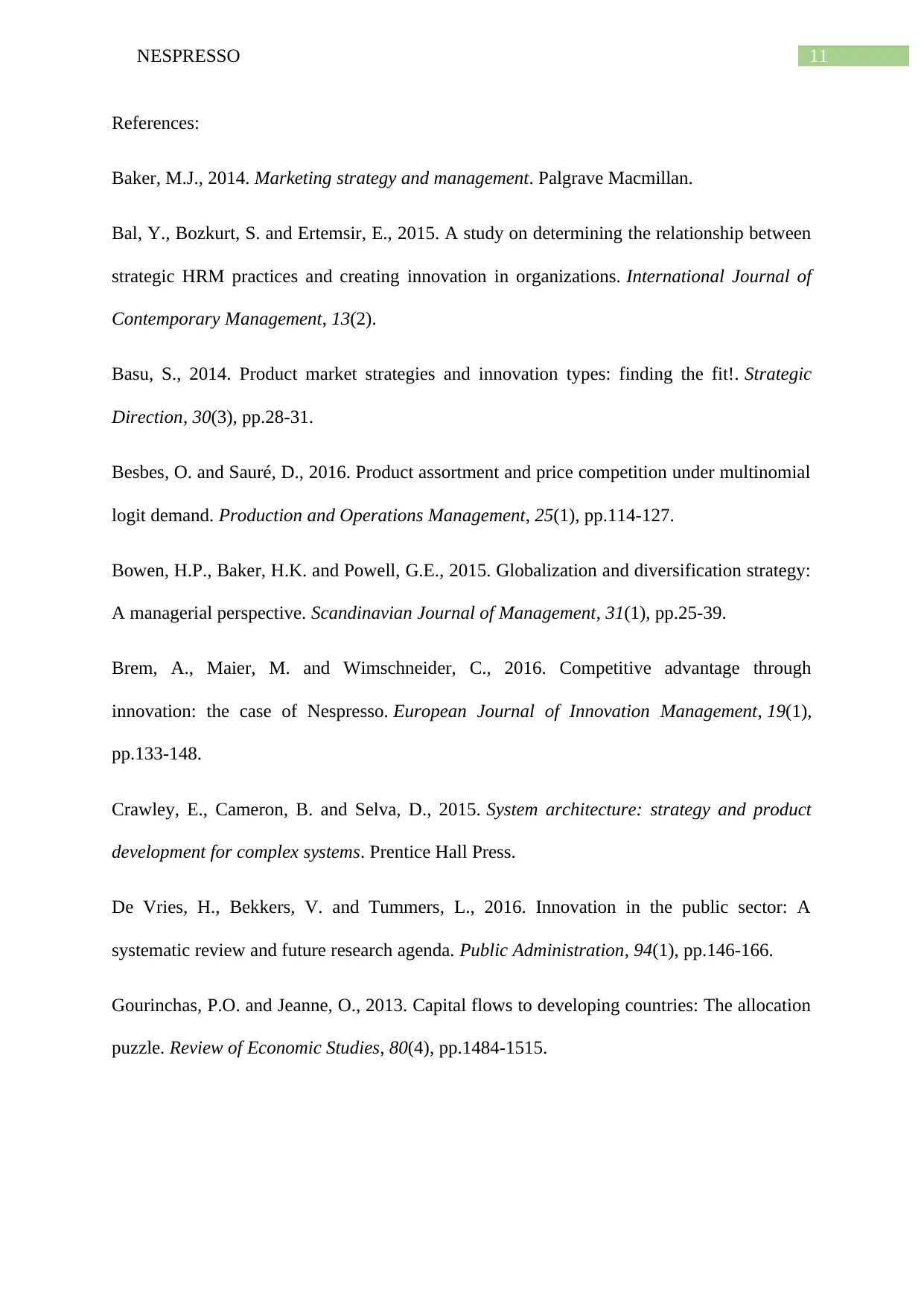
11NESPRESSO
References:
Baker, M.J., 2014. Marketing strategy and management. Palgrave Macmillan.
Bal, Y., Bozkurt, S. and Ertemsir, E., 2015. A study on determining the relationship between
strategic HRM practices and creating innovation in organizations. International Journal of
Contemporary Management, 13(2).
Basu, S., 2014. Product market strategies and innovation types: finding the fit!. Strategic
Direction, 30(3), pp.28-31.
Besbes, O. and Sauré, D., 2016. Product assortment and price competition under multinomial
logit demand. Production and Operations Management, 25(1), pp.114-127.
Bowen, H.P., Baker, H.K. and Powell, G.E., 2015. Globalization and diversification strategy:
A managerial perspective. Scandinavian Journal of Management, 31(1), pp.25-39.
Brem, A., Maier, M. and Wimschneider, C., 2016. Competitive advantage through
innovation: the case of Nespresso. European Journal of Innovation Management, 19(1),
pp.133-148.
Crawley, E., Cameron, B. and Selva, D., 2015. System architecture: strategy and product
development for complex systems. Prentice Hall Press.
De Vries, H., Bekkers, V. and Tummers, L., 2016. Innovation in the public sector: A
systematic review and future research agenda. Public Administration, 94(1), pp.146-166.
Gourinchas, P.O. and Jeanne, O., 2013. Capital flows to developing countries: The allocation
puzzle. Review of Economic Studies, 80(4), pp.1484-1515.
References:
Baker, M.J., 2014. Marketing strategy and management. Palgrave Macmillan.
Bal, Y., Bozkurt, S. and Ertemsir, E., 2015. A study on determining the relationship between
strategic HRM practices and creating innovation in organizations. International Journal of
Contemporary Management, 13(2).
Basu, S., 2014. Product market strategies and innovation types: finding the fit!. Strategic
Direction, 30(3), pp.28-31.
Besbes, O. and Sauré, D., 2016. Product assortment and price competition under multinomial
logit demand. Production and Operations Management, 25(1), pp.114-127.
Bowen, H.P., Baker, H.K. and Powell, G.E., 2015. Globalization and diversification strategy:
A managerial perspective. Scandinavian Journal of Management, 31(1), pp.25-39.
Brem, A., Maier, M. and Wimschneider, C., 2016. Competitive advantage through
innovation: the case of Nespresso. European Journal of Innovation Management, 19(1),
pp.133-148.
Crawley, E., Cameron, B. and Selva, D., 2015. System architecture: strategy and product
development for complex systems. Prentice Hall Press.
De Vries, H., Bekkers, V. and Tummers, L., 2016. Innovation in the public sector: A
systematic review and future research agenda. Public Administration, 94(1), pp.146-166.
Gourinchas, P.O. and Jeanne, O., 2013. Capital flows to developing countries: The allocation
puzzle. Review of Economic Studies, 80(4), pp.1484-1515.
⊘ This is a preview!⊘
Do you want full access?
Subscribe today to unlock all pages.

Trusted by 1+ million students worldwide
1 out of 14
Related Documents
Your All-in-One AI-Powered Toolkit for Academic Success.
+13062052269
info@desklib.com
Available 24*7 on WhatsApp / Email
![[object Object]](/_next/static/media/star-bottom.7253800d.svg)
Unlock your academic potential
Copyright © 2020–2025 A2Z Services. All Rights Reserved. Developed and managed by ZUCOL.





